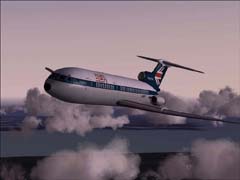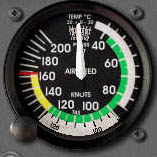
Farmboyzim's Flight Sim's

King Schools - Review 2
Private Pilot Knowledge Test Course
By Farmboyzim

For some background on what this review is going to be dealing with click HERE.
We are going to start this review with "V" speeds, and what they mean. "V" speeds are the velocity limitations that are imposed on a particular aircraft according to their performance capabilities. We'll also talk about the color coded arcs on your airspeed indicator.
(Note: In presenting these "V" speeds, please remember that when you see them in print, the "V" is capitalized, while the corresponding letter representations, the letters that follow the "V" are also in caps but smaller and at the right of the "V", but due to either the limitations of my software, or "operator headspace", (probably the latter!), they are all in caps here.)
These "V" speeds are:
VLE - Represents the maximum speed that you can lower your landing gear at without causing damage.
VX - This speed is the one that will get you the most altitude in the shortest amount of distance during a climb after takeoff.
VY - You'll be able to get the most altitude in a given period of time with this speed.
VA - Represents maneuvering speed. Maneuvering speed is a very important speed, but is not color coded on your airspeed indicator. An important point on maneuvering speeds and air turbulence. When encountering SEVERE turbulence, you should reduce your airspeed to the aircrafts VA speed or slightly less. Then you must maintain a level flight attitude, and allow for minor variations in airspeed and altitude. Don't "chase" the airspeed and flight level, just allow for these small variations.
VSO - This is the stalling speed or minimum steady flight speed while in the landing configuration. In other words, you have your flaps and gear down preparing for landing. Power off stalling speed in this configuration is defined by the lower limit of the white arc on your airspeed indicator. The flap operating range is represented by the white arc, and in your smaller aircraft, i.e. a Cessna 172, this is about 33 - 85 mph.

VFE - Represents maximum flaps extended speed, and is indicated by the upper limit of the white arc, 85 KIAS.
Power off stalling speed with flaps and gear retracted is represented by the lower limit of the green arc. In this case, 45 KIAS.
VNO - The maximum structural cruising speed of the aircraft and is indicated by the upper limit of the green arc, using the figure to the right, this would be about 130 KIAS. Normal operating range of the aircraft is indicated by the green arc.
The caution range of the aircraft's speed is indicated by the yellow arc. In absolutely perfect weather conditions (where and when does this happen?) it is permissible to operate the aircraft in this range, but only when everything is just right weather wise. In the figure provided, this would be from 129 - 163 KIAS.
The "Never Exceed Speed" is indicated by the red line, and is often referred to as "the red line". In the case of the Cessna 172, this is 163 KIAS. This is the max speed that you may operate the aircraft at safely in those "perfect" conditions, without risking leaving your wings behind!
That about covers Airspeed Limitations and the color coded arcs on your airspeed indicator. Let's move on now to the next topic which is Vortices, or Wake Turbulence and Ground Effect.
WAKE TURBULENCE
When large aircraft take off, they develop lift, which creates a very dangerous hazard called Wingtip Vortices. This is created only when the aircraft is developing lift. When the generating aircraft is heavy, clean (flaps up, gear up), and slow, this hazard is at its greatest. This could also be when they are landing. These vortices created by the wingtips of the heavy aircraft tend to sink into the flight path of any aircraft operating below it. When the vortices hit the ground, they will spread and drift with the wind. When there is a light, quartering tailwind, and you are landing behind such an aircraft that is causing this effect, maximum caution must be applied, for this is a very dangerous situation. If you have to land behind a large aircraft, you should try to stay above the large aircrafts final approach path and land beyond the large aircrafts touchdown point. If you happen to be departing behind a large aircraft, you should avoid the wake turbulence by maneuvering the aircraft above and upwind from the heavy.
GROUND EFFECT
The interference of the surface of the earth with the airflow patterns about an airplane is known as ground effect. An aircraft will fly more efficiently while in the ground effect zone. This is due to a decreased drag on the aircraft. While taking off, this may have the effect of becoming airborne before the proper takeoff speed has been reached. Upon landing, ground effect may cause considerable floating if the speed of the aircraft is to high at the point of flare. This "zone" of ground effect takes place when the aircraft is less than the length of the wingspan above the surface.
Watch for the next installment soon, on Flight Instruments.
For more information on course and products offered by King Schools, visit: www.kingschools.com



Thanks For The Visit !









